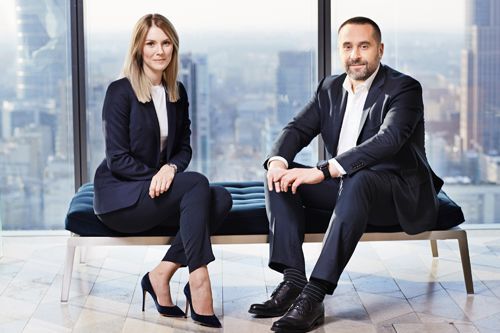Which way to Invest in industrial assets?
Law
The industrial and logistics market in Poland has been motoring forward at a feverish pace. The sector has foundations strong enough not only to continue growing, but also to break out into new areas, due to the rapid growth of the e-commerce sector and the expansion of the country’s modern road networks. The market continues to adapt to reflect client needs. ‘Last mile’ logistics clients, who require urban schemes allowing for quick and efficient distribution, are one example of this.
Apart from urban projects, the market’s stable growth is being driven by multi-tenant projects developed both in core locations and also in up-and-coming cities, such as Toruń, Białystok, Bydgoszcz, Kielce and Lublin. Alongside this, we are experiencing an increased interest in BTS and particularly BTO projects, which largely depend on the individual needs of a particular occupier.
Moreover, the number of developers offering different types of products and services, such as standing assets, joint ventures or forward funding programmes, is still growing and new platforms are being set up. Choosing the right professional partner to join up with for a transaction is a crucial element.
For an investor interested in structuring and executing a logistics project, there are some legal aspects that are worth considering.
Diligence first of all
Before any process can be kicked off, a due diligence survey has to be done. These surveys are one of the most important elements of any industrial project. The main goal of this exercise boils down to the following two questions: Am I buying a good title to a property that is not burdened by any onerous encumbrances? And, will I be able to develop my desired project on this property?
Answering the first question requires, in particular, a review of the land and mortgage register files kept by the local courts, a task performed by lawyers. Such files disclose information on the legal status of properties, their ownership titles, encumbrances, etc. In order to answer the second question, close cooperation between lawyers and technical advisors is required. In order to confirm that the intended project can be developed on a property, both teams should meticulously review the provisions of the local zoning plan and also consider such circumstances as: the existence of any archaeological sites, the agricultural or forest status of a property, and the environmental history of the site.
The development process for new projects in Poland can be better understood if we imagine it as a chain of events occurring in a prescribed order.
Firstly, an investor should obtain an environmental permit, which lays down the basic environmental requirements. Following this, a zoning permit needs to be obtained, unless a property is covered by a master plan. A zoning permit specifies a few of the basic architectural parameters of the planned investment, such as the investment area, the building’s height, the density ratio, etc. Subsequently, based on the environmental permit and zoning permit, the investor has to prepare a building design and obtain a building permit to begin the construction work. Following the completion of construction, an occupancy permit has to be obtained, which allows for the operation of the building. Accompanying the above-mentioned permits are usually other permits that have to be obtained during the development phase, such as water permits.
Financing structures
There are a number of structures for financing projects worth taking into account. Firstly, an investor might consider whether a professional developer is needed for either a turn-key development or services related to the management of the development process. If the answer to this question is yes, then the next question is how to structure the cooperation between a financial investor and a professional warehouse developer?
In a typical forward funding scenario, the developer generally takes the entire development risk (under a turn-key contract), while the investor buys a fully completed building leased to a third party tenant. This is achieved by concluding a development management agreement based upon which the investor reimburses the costs related to the construction of the building and pays the developer an agreed development fee (usually a certain percentage of the costs related to the development), which constitutes the developer’s remuneration for its actions undertaken under the development management agreement. In the latter case, it is also common to commission to the same developer with the provision of the leasing services. Initial leasing services are usually performed under the development management agreement for a leasing fee made up of a percentage of the annual rent under a given lease as remuneration. Further leasing services after the completion of the building (following the issuing of the occupancy permit) can also be performed by the developer, based on the property management agreement. In the case of BTS projects, the lease agreement is often even executed prior to the development management agreement being put in place.
In a joint venture scenario, the parties contributing equity to the project sign a shareholders’ agreement regulating the JV, with a particular focus on the specific rights and obligations of each shareholder, the manner of running the project and the distribution of the profit from it. Such a scheme requires the developers to inject equity into the development, but also allows the development risk to be balanced so that it does not rest entirely on the developer’s shoulders. The joint venture structure is clearly more popular for investors interested in the development of a portfolio of assets with multiple tenants, rather than BTS projects.
Both of the scenarios described above raise similar challenges for the parties to such transactions, such as the liability of each of the parties, non-competition provisions and non-poaching clauses.
Legal and tax issues to be considered
In the event of the purchase of a standing asset, it is essential to assess the structure of the transaction. The decision underlying which transaction structure will be used depends mostly on the relevant legal and tax implications. The most common methods of structuring real estate transactions in Poland these days are: the sale of shares in the SPV holding the asset (a share deal), where the investor buys the shares of the company that owns the land, building, structures, facilities or movables (as applicable) as well as other rights and obligations; and the sale of the real estate (an asset deal). These two approaches are taxed differently: the sale of shares is subject to non-recoverable TCLT (civil law transaction tax) at 1 pct of the NAV, while an asset deal is subject to VAT (typically 23 pct). In contrast to transfer tax, VAT is usually recoverable once the deal has closed. ν





















































